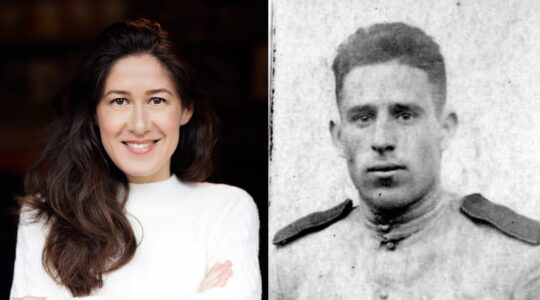Question: Where is the largest and arguably the most impressive synagogue on the Iberian Peninsula?
Answer: Not where you’d think.
The Kadoorie Mekor Haim Synagogue, it turns out, is in Porto, one of the largest cities in Portugal and arguably among its most impressive in terms of beauty and historical import. Inaugurated in 1938 — not a banner year for European synagogues, overall — the Kadoorie is just one reason Porto deserves more attention from the Jewish traveler.
Among the others: A dramatic riverfront setting, with cantilevered bridges over the district where Jews settled in the Middle Ages. An urban palimpsest of Jewish Iberian history, where ancient mezuzot are still visible on the door frames in certain quarters, and blue-and-white tile facades lend an air of serene melancholy. And in the heart of Portugal’s hilly, verdant Douro region, some of the best local wine anywhere in Europe.
The Kadoorie Synagogue — as it is known — is today both a historical landmark and the modern headquarters of the Jewish community of Porto. Hushed and elegant, its intricate Moorish-style interior suffused in a golden glow, the temple houses a series of historical exhibits on its first floor. Tour its sanctuary and you may mingle with members of the Community — an entity formally established in 1923 by one Captain Barros Basto, who worked to congregate the descendants of medieval Portuguese Jews.
Most of these families practiced Judaism in secret after forced conversions. That sorry chapter marked the decline of Iberian Jewry after a thousand years in Porto, during which time Jewish communities flourished in several of what are today central-city districts. Protected by a series of more-enlightened monarchs, Porto’s Jews are remembered for their scientific and financial contributions to the country’s Age of Discovery.
That golden age is a half-millennium in the rearview mirror — a fact evident to anyone wandering around modern-day Porto. Despite its size and strategic location, the city feels deeply provincial, exiled literally and figuratively to Europe’s margin.
I pondered this while wandering Porto’s vertical alleys, where the stoic faces around me bore witness to hardship. For centuries, poor, isolated Portuguese stared up at the lavish palaces, cathedrals and towers that were vestiges of a more prosperous era. Today a similar phenomenon is taking hold, as many struggle to pay electricity bills in the glow of upscale chain stores, first-world highways and other reminders of the fleeting fruits of European integration.
But the ephemera of progress were the last thing on my mind as I gazed up at Porto’s ageless towers and tiled façades on a brilliant, cloudless morning. Tracing the arc of Jewish Porto meant heading for the historic neighborhoods that sprawl along the steep banks of the Douro River, their red-tile roofs baking under a hot Iberian sun.
While few Jews call Porto home today, medieval communities occupied multiple quarters of the Old City. One such district was in the area around the Cathedral, with its rose-and-gold interior, and the Torre dos Clérigos, the soaring Baroque obelisk that has been an urban landmark for centuries. Less remains of Porto’s first synagogue on Rua Santana — nor of another Jewish quarter to the west, surrounding the Infante D. Henrique Plaza, which marks the historic center of Porto.
To step inside the Palácio da Bolsa, whose neoclassical edifice looms over the square, is to step into a grand, nostalgic vision of Portuguese prosperity. Nearby on the Rua do Comercio, where Jewish merchants once congregated, there is little evidence of either Jewish life or prosperity; all that remains are charmingly dingy façades, garnished with wrought-iron balconies and punctuated by baroque churches.
I made my way down to the river, where the expanse of sky and water provided a welcome contrast to Porto’s dark, narrow streets. Colorful tugboats glided by the riverfront promenade; fans of the Porto soccer club were already filling cafes, singing and chanting over platters of fried fish.
The Douro River runs east to west — and so did Porto Jews. That is how the Kadoorie Synagogue came to be built in Boavista, a neighborhood where the post-expulsion Jewish community coalesced in the 17th and 18th centuries. West and slightly inland from the city center, Boavista is today a tranquil district filled with parks and fountains.
But the loveliest park of all is the 44-acre campus of the Serralves Foundation, Portugal’s national modern-art institution, which lies just a short stroll from the synagogue.
Like so many architecturally distinguished temples of modern art, everything about the Serralves is more exciting than the actual art — the arresting formal gardens, all dark-green rectangles and limpid pools; winding paths through acres of flowering forest; and especially the pink Art Deco palace at the heart of the estate, one of Portugal’s most iconic buildings.
It was pleasant enough to stroll through the light-filled museum, which showcases aesthetic currents of contemporary Iberia. But it was even more pleasant to picnic outside in the shadow of abstract sculptures, listening to the shush-shush chatter of Portuguese families, enjoying a respite from the weight of a dolorous past.
The New York Jewish Week brings you the stories behind the headlines, keeping you connected to Jewish life in New York. Help sustain the reporting you trust by donating today.




